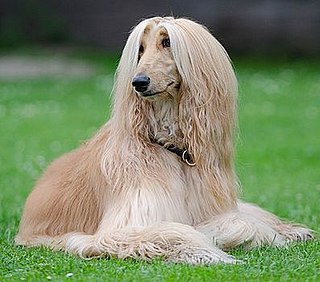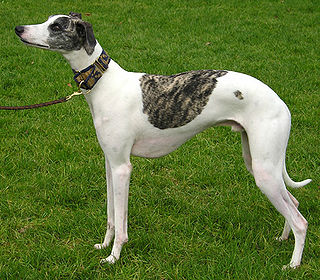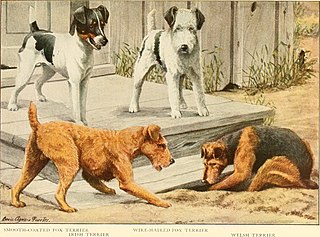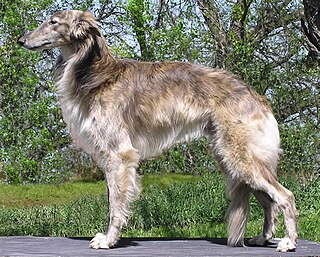
The Afghan Hound is a hound distinguished by its thick, fine, silky coat, and a tail with a ring curl at the end. The breed originates in the cold mountains of Afghanistan. Its local name is Sag-e Tāzī or Tāžī Spay. Other names for this breed are Tāzī, Balkh Hound, Baluchi Hound, and Barakzai Hound.

The Azawakh is a breed of dog from West Africa. With ancient origins, it is raised throughout the Sahelian zone of Mali, Niger, and Burkina Faso. This region includes the Azawagh Valley for which the breed is named. While commonly associated with the nomadic Tuareg people, the dogs are also bred and owned by other ethnic groups, such as the Peulh, Bella, and Hausa. The Azawakh is more related to the Sloughi than it is to the Saluki.

The Italian Greyhound or Italian Sighthound is an Italian breed of small sighthound. It was bred to hunt hare and rabbit, but is kept mostly as a companion dog.

Sighthounds are a type of hound dog that hunts primarily by sight and speed, unlike scent hounds, which rely on scent and endurance.

The Sloughi, or Arabian Greyhound, is an ancient breed of domesticated dog, specifically a member of the sighthound family. It originates from North Africa and is found in Algeria, Tunisia, Morocco and Libya.

The whippet is a British breed of medium-sized dog, of the sighthound type, related to the larger greyhound and the smaller Italian greyhound. Apart from the differences in height, the whippet closely resembles these two breeds; it has sometimes been described as "the poor man's greyhound". It is kept as a companion dog, for competitive showing, for amateur racing as well as lure coursing. It has the highest running-speed of any breed in its weight and size range, and may have the fastest idle-to-running acceleration of any dog.

Terrier is a type of dog originally bred to hunt vermin. A terrier is a dog of any one of many breeds or landraces of the terrier type, which are typically small, wiry, game, and fearless. There are five different groups of terrier, with each group having different shapes and sizes.
Lure coursing is a sport for dogs that involves chasing a mechanically operated lure. Competition is typically limited to dogs of purebred sighthound breeds. The AKC has a pass/fail trial for all breeds called the Coursing Ability Test (CAT) and a timed 100 yard dash called Fast CAT where the dog's speed is converted to points.

The Fédération Cynologique Internationale is the largest international federation of national kennel clubs and purebred registries. The FCI is based in Thuin, Belgium and has 98 members and contract partners.

The Poodle, called the Pudel in German and the Caniche in French, is a breed of water dog. The breed is divided into four varieties based on size, the Standard Poodle, Medium Poodle, Miniature Poodle and Toy Poodle, although the Medium Poodle is not universally recognised. They have a distinctive thick, curly coat that comes in many colors and patterns, with only solid colors recognized by breed registries. Poodles are active and intelligent, and are particularly able to learn from humans. Poodles tend to live 10–18 years, with smaller varieties tending to live longer than larger ones.
Toy dog traditionally refers to a very small dog or a grouping of small and very small breeds of dog. A toy dog may be of any of various dog types. Types of dogs referred to as toy dogs may include spaniels, pinschers and terriers that have been bred down in size. Not all toy dogs are lap dogs.

The Lhasa Apso is a non-sporting dog breed originating in Tibet. Traditionally the breed has been used as an interior watchdog.

The Pont-Audemer Spaniel or Epagneul Pont-Audemer is a rare breed of French gundog. It originated in the nineteenth century from different breeds of water spaniels, and took more of a setter role in hunting than that of a traditional spaniel. Following the Second World War, the breed's numbers dropped so low that the breed club decided to allow cross breeding with other breeds because of fears of the existing stock becoming overly inbred. In 1980, the breed club was merged with that of the Picardy Spaniel.

The Polish Greyhound is a Polish sighthound breed. Despite its name, it is not a direct relative of the Greyhound dog.

The Silken Windhound is an American breed of sighthound. Like most sighthounds, Silkens are noted coursers.

Danish–Swedish farmdog is a breed of dog that has its origin in Denmark and southern Sweden, but has become popular all over Scandinavia. It is a native breed which has historically lived on farms in the eastern part of Denmark and southernmost part of Sweden, serving as a guard dog, rat catcher and hunting dog. The breed's soft and gentle temperament also makes them excellent companion dogs. There are some indications that the breed originates from the pinscher breeds and the British white hunting terriers.

The Basset Bleu de Gascogne, also known as the Blue Gascony Basset, is a long-backed, short legged breed of dog of the hound type. A French native breed, it is rare outside its homeland. It is recognized internationally by the Fédération Cynologique Internationale, in the UK by The Kennel Club, and by the United Kennel Club in the United States. The "bleu" of its name is a reference to its coat which has a ticked appearance.

The Transylvanian Hound is a dog breed originating from Hungary and Transylvania and was historically primarily used for hunting. It is a strong, medium-sized scent hound, characterized by a black body, with tan and sometimes white markings on the muzzle, chest and extremities, and distinctive tan eyebrow spots. It has a high-pitched bark for a dog of its size. The breed was rescued from extinction by focused breeding efforts in the late 20th century. There were formerly two varieties, the tall and the short, developed for different kinds of hunting in the Middle Ages. Only the tall variety survives today.

Raad van Beheer op Kynologisch Gebied in Nederland is the official kennel club of the Netherlands. Founded in 1902, it currently represents around 200 breed clubs with 150,000 members, and is a member of the Fédération Cynologique Internationale (FCI).

The American Staghound, referred to by various names including the Cold-Blooded Greyhound, the Longdog of the Prairie and the American Lurcher, is a crossbreed of various sighthounds. It has been bred in the United States from the 19th century where it is used for hunting.






























